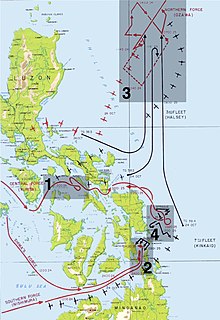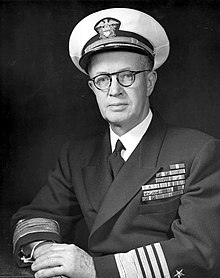Robert Carney
Robert Bostwick Carney (born March 26, 1895 in Vallejo , California - † June 25, 1990 in Washington, DC ) was an American admiral in the US Navy , who was commander in chief of the US naval forces in the Eastern Atlantic and Mediterranean between 1950 and 1952 ( Commander-in-Chief of the US Naval Forces Eastern Atlantic and Mediterranean ) and Chief of Naval Operations from 1953 to 1955 .
Life
Naval officer training and uses
Carney joined the US Navy after school in 1912 and graduated from the US Naval Academy in Annapolis , from which he graduated on June 3, 1916 with a Bachelor of Science (BS) as a Marine Lieutenant . He then found his first assignment as a naval officer on the battleship USS New Hampshire and was then transferred in October 1916 to the USS Dixie , a tender of the Atlantic torpedo flotilla. In 1917 he became an officer on the USS Fanning , a destroyer of Paulding class before it in July 1918, a delegation of the Bethlehem Shipbuilding Corporation in Squantum completed in order there to the Clemson-class destroyer belonging newly built destroyer USS leaves to take over. He then served in succession on the USS Reno (Clemson-class destroyer), USS Rathburne ( Wickes-class destroyer ), USS Delphy (Clemson-class destroyer), the battleship USS Mississippi and the battleship between 1920 and 1928 USS New Mexico .
Carney then worked in the Fleet Training Department in the Chief of Naval Operations' office between August 1928 and April 1930 and then an officer on the light cruiser USS Cincinnati , before becoming Commanding Officer of the receiving station and war planning officer of the naval cannon factory between June 1933 and June 1935 Washington Navy Yard was, a naval yard and arms factory in Washington, DC Between 1936 and 1937 he was first in command of the destroyer USS Buchanan and then the Mahan-class destroyer USS Reid .
Second World War

During a subsequent activity in the Department of Coastal Facilities in the Office of the Deputy Secretary of the Navy (Assistant US Secretary of the Navy ) from August 1938 to June 1940, he was the latter's aide-de-camp during the visit of Crown Prince Olav of Norway to the USA in the summer of 1939 camp . In June 1940 he became the first officer ( Executive Officer ) of the battleship USS California and remained in this post until February 1941. He then served from March 1941 to September 1942 with the support organizations of the US Atlantic Fleet . During this time, more than 2,600 ships were escorted with only six ships lost. He was awarded the first of four Navy Distinguished Service Medals for his services there and his achievements in the submarine war .
In October 1942 Carney became commandant of the newly built and Cleveland-class light cruiser USS Denver , which he commanded in the Southwest Pacific until July 1943 . He was awarded the Bronze Star and the Legion of Merit for his services during the Battle of Guadalcanal .
Then he acted according to his promotion to rear admiral from July 1943 to July 1945 as chief of staff and aide-de-camp of Admiral William F. Halsey , commander of the armed forces in the South Pacific or commander of the US 3rd Fleet. He was awarded the second Navy Distinguished Service Medal for planning and organizing logistical support for the Allied units in the Pacific. His tactics in the operations of the 3rd US Fleet in the sea and air battle in the Gulf of Leyte in October 1944, in which most of the Imperial Japanese Navy was destroyed, led to the award of the Navy Cross and later of two other Navy Distinguished Service Medal. In this capacity, he also formally accepted the surrender of Japan in Yokosuka , the second largest secret Japanese naval base, in August 1945 as the representative of the USA .
In February 1946, Carney Vice Chief of Naval Operations or later Deputy Chief of Naval Operations for Logistics was in the Navy Department ( US Department of the Navy ) and remained in that role until the 1950s.
On April 1, 1950, he formally took over command of the Second Task Fleet in the Atlantic and five months later in September 1950, succeeding Admiral Richard L. Connolly, he became Commander-in-Chief of the US Naval Forces in the Eastern Atlantic and Mediterranean CINCNELM (Commander -in-Chief of the US Naval Forces Eastern Atlantic and Mediterranean) . He remained in this post until his replacement by Admiral Jerauld Wright in June 1952. On June 18, 1951, he was also first Commander-in-Chief of the Allied Forces in Southern Europe AFSOUTH ( Allied Forces Southern Europe ) of NATO and in personal union Commander-in-Chief of the Allied Naval Forces in Southern Europe NAVSOUTH (Allied Naval Forces Southern Europe) .
Admiral Carney finally succeeded Admiral William Fechteler as Chief of Naval Operations on August 17, 1953 , making him the highest ranking naval officer and admiral chief of staff in the US Navy. He held this post for exactly two years until August 17, 1955, when he was retired. He was succeeded by Admiral Arleigh Burke .
After retiring, he moved into the private sector and became, among other things, chairman of the board of directors of the Bath Iron Works shipyard and a board member of the aircraft manufacturer Fairchild Engineer Aircraft Corporation and the security company Nationwide Securities, Inc.
Carney Island , an island in the Amundsen Sea in the Southern Ocean , was named in his honor . After his death, he was buried in Arlington National Cemetery.
publication
- Evolutionary Aspects of Command. A Lecture devilvered at Naval War College, May 31, 1963 , in: Naval War College Review , September 1963, pp. 1-13
Web links
- Short biography in the Naval War College Review , September 1963, p. 14 f.
- Adm. Robert B. Carney, 95, Dies; Former Chief of Naval Operations . In: The New York Times, June 27, 1990
- Admiral Robert B. “Mick” Carney '16, USN (Deceased) on the US Navy Academy homepage
- NOTABLE GRADUATES: Chief of Naval Operations Robert B. Carney, Class of 1916 on the US Navy Academy homepage
- ROBERT B. CARNEY, REAR ADMIRAL (1895-1990)
- Robert Bostwick Carney, 26 March 1895 - 25 June 1990 on the Navy History and Heritage Command home page
- Entry on the homepage of Arlington National Cemetery
Individual evidence
| personal data | |
|---|---|
| SURNAME | Carney, Robert |
| ALTERNATIVE NAMES | Carney, Robert Bostwick (full name) |
| BRIEF DESCRIPTION | American officer, admiral in the United States Navy |
| DATE OF BIRTH | March 26, 1895 |
| PLACE OF BIRTH | Vallejo , California |
| DATE OF DEATH | June 25, 1990 |
| Place of death | Washington, DC |

